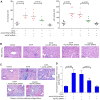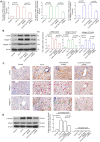Adenovirus‑mediated knockdown of activin A receptor type 2A attenuates immune‑induced hepatic fibrosis in mice and inhibits interleukin‑17‑induced activation of primary hepatic stellate cells
- PMID: 29620144
- PMCID: PMC5979935
- DOI: 10.3892/ijmm.2018.3600
Adenovirus‑mediated knockdown of activin A receptor type 2A attenuates immune‑induced hepatic fibrosis in mice and inhibits interleukin‑17‑induced activation of primary hepatic stellate cells
Abstract
Fibrosis induces a progressive loss of liver function, thus leading to organ failure. Activins are secreted proteins that belong to the transforming growth factor (TGF)‑β superfamily, which initiate signaling by binding to their two type II receptors: Activin A receptor type 2A (ACVR2A) and activin A receptor type 2B. Previous studies that have explored the mechanisms underlying immune‑induced hepatic fibrosis have mainly focused on TGF‑β signaling, not activin signaling. To investigate the role of the activin pathway in this disease, adenovirus particles containing short hairpin (sh)RNA targeting ACVR2A mRNA (Ad‑ACVR2A shRNA) were administered to mice, which were chronically treated with concanavalin A (Con A). The pathological changes in the liver were evaluated with hematoxylin/eosin staining, Masson trichrome staining and immunohistochemical assay. The results detected an increase in serum activin A and liver ACVR2A in Con A‑treated animals. Conversely, liver function was partially restored and fibrotic injury was attenuated when activin signaling was blocked. In addition, the activation of hepatic stellate cells (HSCs) in response to Con A was suppressed by Ad‑ACVR2A shRNA, as evidenced by decreased α‑smooth muscle actin, and type I and IV collagen expression. Furthermore, primary mouse HSCs (mHSCs) were activated when exposed to interleukin (IL)‑17A or IL‑17F, which are two major cytokines produced by cluster of differentiation 4+ T helper 17 cells. The levels of activin A, type I and IV collagen were determined with ELISA kits and the expression of fibrotic molecules was determined with western blot analysis. Conversely, blocking activin/ACVR2A impaired the potency of HSCs to produce collagens in response to IL‑17s. In addition, C terminus phosphorylation of Smad2 on Ser465 and Ser467, induced by either Con A in the liver or by IL‑17s in mHSCs, was partly inhibited when activin A/ACVR2A signaling was suppressed. Collectively, the present study demonstrated an involvement of activated activin A/ACVR2A/Smad2 signaling in immune‑induced hepatic fibrosis.
Figures





Similar articles
-
Activin-A causes Hepatic stellate cell activation via the induction of TNFα and TGFβ in Kupffer cells.Biochim Biophys Acta Mol Basis Dis. 2018 Mar;1864(3):891-899. doi: 10.1016/j.bbadis.2017.12.031. Epub 2017 Dec 26. Biochim Biophys Acta Mol Basis Dis. 2018. PMID: 29287776
-
Magnolol Attenuates Concanavalin A-induced Hepatic Fibrosis, Inhibits CD4+ T Helper 17 (Th17) Cell Differentiation and Suppresses Hepatic Stellate Cell Activation: Blockade of Smad3/Smad4 Signalling.Basic Clin Pharmacol Toxicol. 2017 Jun;120(6):560-570. doi: 10.1111/bcpt.12749. Epub 2017 Mar 7. Basic Clin Pharmacol Toxicol. 2017. PMID: 28032440
-
New role and molecular mechanism of Gadd45a in hepatic fibrosis.World J Gastroenterol. 2016 Mar 7;22(9):2779-88. doi: 10.3748/wjg.v22.i9.2779. World J Gastroenterol. 2016. PMID: 26973416 Free PMC article.
-
Neuroimmunomodulation of adrenoblockers during liver cirrhosis: modulation of hepatic stellate cell activity.Ann Med. 2023 Dec;55(1):543-557. doi: 10.1080/07853890.2022.2164047. Ann Med. 2023. PMID: 36826975 Free PMC article. Review.
-
Crosstalk between NK cells and hepatic stellate cells in liver fibrosis (Review).Mol Med Rep. 2022 Jun;25(6):208. doi: 10.3892/mmr.2022.12724. Epub 2022 May 4. Mol Med Rep. 2022. PMID: 35506449 Free PMC article. Review.
Cited by
-
Activin A as a Novel Chemokine Induces Migration of L929 Fibroblasts by ERK Signaling in Microfluidic Devices.Front Cell Dev Biol. 2021 May 21;9:660316. doi: 10.3389/fcell.2021.660316. eCollection 2021. Front Cell Dev Biol. 2021. PMID: 34095123 Free PMC article.
-
IL-17a promotes hepatocellular carcinoma by increasing FAP expression in hepatic stellate cells via activation of the STAT3 signaling pathway.Cell Death Discov. 2024 May 13;10(1):230. doi: 10.1038/s41420-024-01995-4. Cell Death Discov. 2024. PMID: 38740736 Free PMC article.
-
Gastrointestinal pharmacology activins in liver health and disease.Biochem Pharmacol. 2023 Aug;214:115668. doi: 10.1016/j.bcp.2023.115668. Epub 2023 Jun 25. Biochem Pharmacol. 2023. PMID: 37364623 Free PMC article. Review.
-
Revealing spatial multimodal heterogeneity in tissues with SpaTrio.Cell Genom. 2023 Nov 27;3(12):100446. doi: 10.1016/j.xgen.2023.100446. eCollection 2023 Dec 13. Cell Genom. 2023. PMID: 38116121 Free PMC article.
-
Antagonistic effects of activin A and TNF-α on the activation of L929 fibroblast cells via Smad3-independent signaling.Sci Rep. 2020 Nov 26;10(1):20623. doi: 10.1038/s41598-020-77783-8. Sci Rep. 2020. PMID: 33244088 Free PMC article.
References
MeSH terms
Substances
LinkOut - more resources
Full Text Sources
Other Literature Sources
Medical
Molecular Biology Databases

